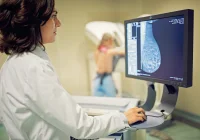The classification of human epidermal growth factor receptor 2 (HER2) expression in breast cancer has undergone significant transformation with the identification of HER2-low as a distinct category. Traditional assessment methods using immunohistochemistry (IHC) and fluorescence in situ hybridisation (FISH) are invasive, costly and time-consuming, creating a need for a noninvasive alternative. Ultrasound-based radiomics has emerged as a promising approach, capable of capturing tumour and peritumoural characteristics to predict HER2 status dynamically.
Must Read: Predicting Breast Cancer Using Sequential Mammogram Analysis
A recent multicentre study developed a radiomics model integrating ultrasound features and clinical data to classify HER2 status into three categories: HER2-positive, HER2-low and HER2-zero. This innovative approach aims to enhance preoperative decision-making and treatment selection, reducing the reliance on invasive diagnostic techniques.
Development of an Ultrasound-Based Radiomics Model
The study enrolled 1257 patients diagnosed with invasive breast cancer from three medical centres between May 2018 and December 2023. HER2 status was classified into three groups, and radiomics features were extracted from both intratumoural and peritumoural regions at various thicknesses (5mm, 10mm, 15mm and 20mm). These regions of interest (ROIs) were automatically generated by expanding manually segmented intratumoural ROIs, allowing for the capture of additional imaging characteristics surrounding the tumour. A machine-learning model was developed using the least absolute shrinkage and selection operator (LASSO) and LightBoost algorithms to identify relevant tumour characteristics. The feature selection process involved evaluating 4720 radiomics features from each patient’s ultrasound images, ensuring only the most significant variables were included in the final model. The most effective model integrated 12 tumour-derived features and nine features from the 15mm peritumoural region, achieving high accuracy in distinguishing HER2-low breast cancer from other classifications.
Performance and Validation of the Model
The developed model was validated using training, validation and test cohorts, achieving strong predictive performance with macro-area under the curve (AUC) scores of 0.988, 0.915 and 0.862, respectively. The integration of age, tumour size and ultrasound-derived qualitative features into the radiomics model further enhanced its discriminatory ability. To ensure robustness, a data stitching strategy was employed, allowing multiple ultrasound images per patient to be aggregated, mimicking the workflow of radiologists who assess lesions from different angles. This approach helped refine the model’s predictive accuracy, ensuring that subtle variations in imaging characteristics were accounted for.
The combined clinical-radiomics model outperformed standalone radiomics or clinical models, demonstrating its reliability in predicting HER2 status across diverse patient populations. Furthermore, the use of Shapley additive explanations (SHAP) provided interpretability to the model, explaining how different imaging features contributed to predictions and enhancing its clinical applicability.
Implications for Personalised Treatment
The ability to non-invasively assess HER2 expression holds significant clinical implications for guiding targeted therapies. HER2-low breast cancers often respond to specific antibody-drug conjugates, necessitating precise classification. The study’s findings suggest that peritumoural radiomics features contribute valuable biological insights, capturing tumour microenvironment dynamics, including angiogenesis, lymphatic invasion and peritumoural oedema. These features may reflect underlying biological processes that influence tumour behaviour and response to treatment. By offering an interpretable and reproducible assessment of HER2 status, ultrasound-based radiomics presents an opportunity to refine treatment strategies and personalise therapeutic interventions.
Moreover, the study reinforces the importance of integrating imaging biomarkers with clinical data, as combining multiple sources of information improves classification accuracy and enhances clinician decision-making. The inclusion of peritumoural data is particularly valuable, as it provides a more comprehensive evaluation of tumour heterogeneity and surrounding tissue interactions, further supporting its role in personalised medicine.
This study underscores the potential of ultrasound-based radiomics in accurately predicting HER2-low breast cancer, providing a non-invasive, cost-effective alternative to traditional biopsy methods. The integration of intratumoural and peritumoural imaging data within an AI-driven framework enhances classification accuracy, aiding clinicians in making informed treatment decisions. The model’s ability to distinguish HER2-positive, HER2-low and HER2-zero breast cancers with high precision offers a valuable tool for preoperative assessment, reducing the reliance on invasive diagnostic procedures.
Future research should focus on refining the model through prospective validation and integrating multimodal imaging data, such as Doppler and elastography ultrasound, to further improve diagnostic precision and clinical applicability. Additionally, automation of the segmentation process could enhance efficiency, reduce variability and improve accessibility for wider clinical use. By advancing non-invasive diagnostics, ultrasound-based radiomics could significantly contribute to the evolution of breast cancer management, facilitating early detection and optimised treatment strategies tailored to individual patient profiles.
Source: Insights into Imaging
Image Credit: iStock








